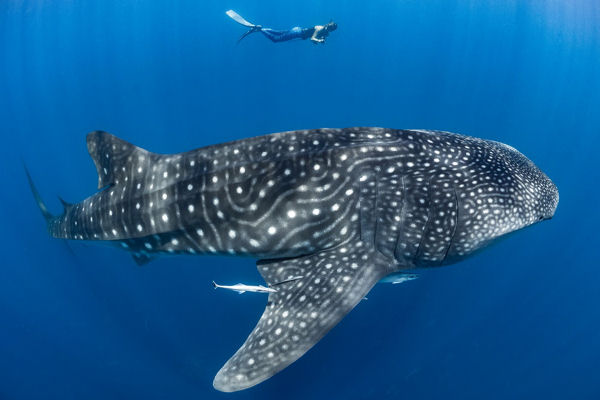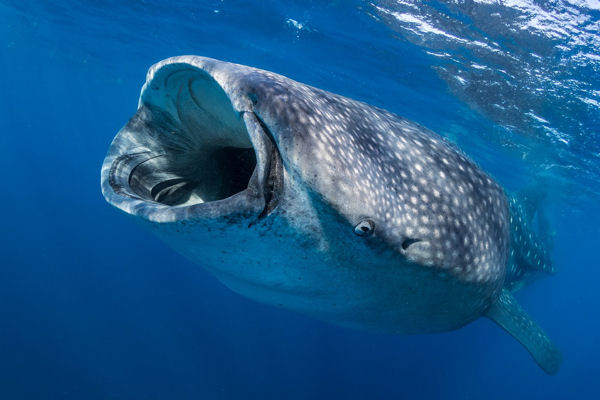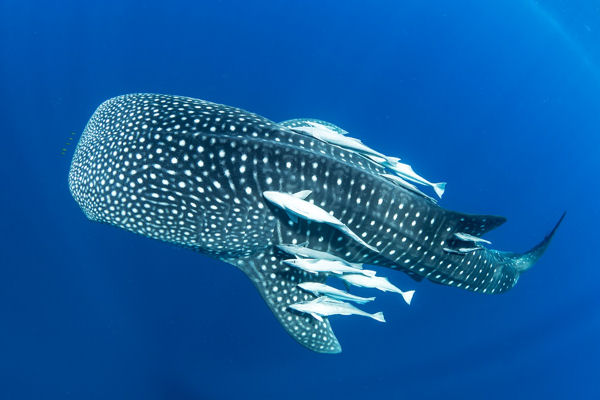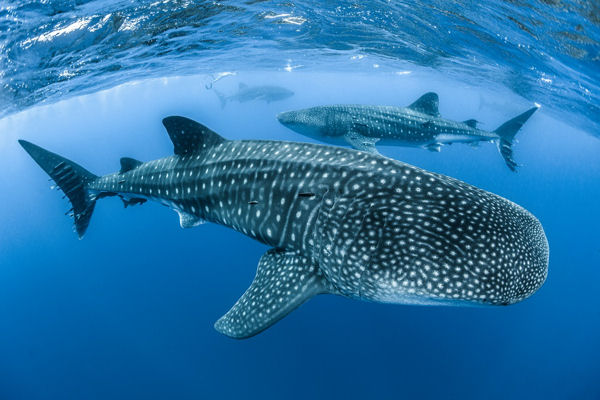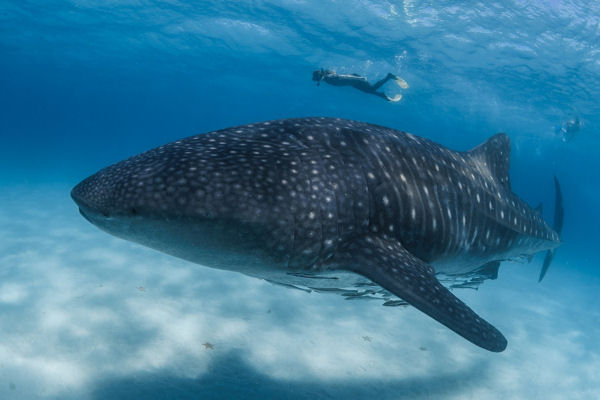IUCN Category:

ENDANGERED
A2bd+4bd
Species Name (Common):
Whale Shark
Species Name (Scientific):
Rhincodon typus
The Whale Shark is not a whale, but is the largest known fish species, growing to over 18m (60ft) long.
Habitat Type:
Marine Neritic, Marine Oceanic
Geographic Range:
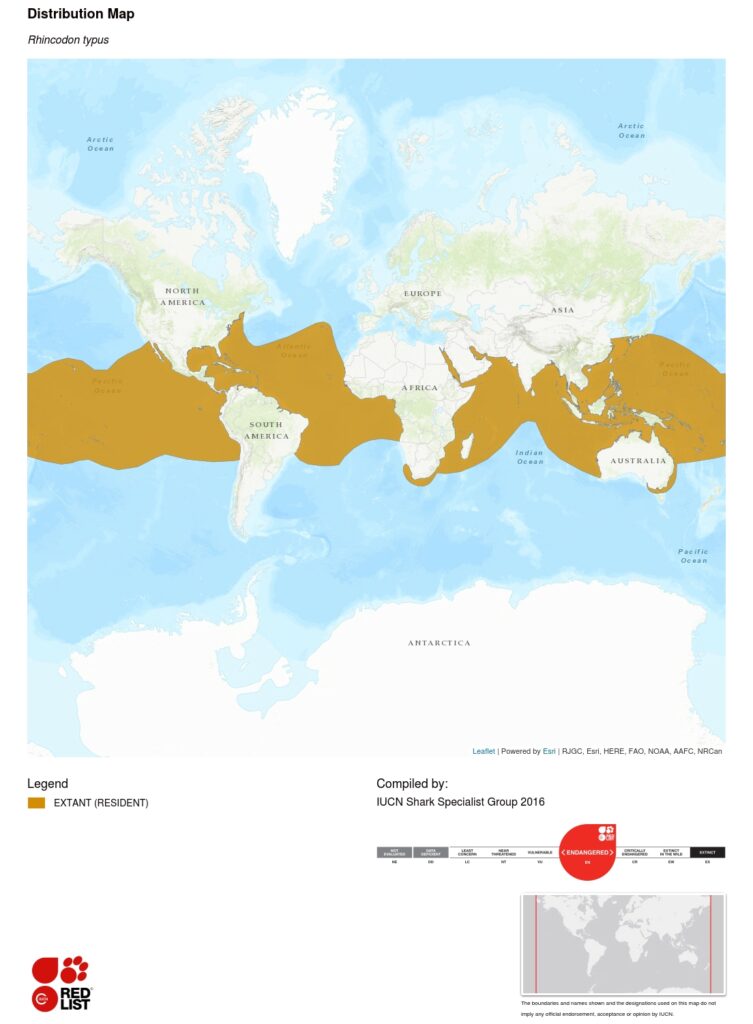
Range:
Whale Sharks are found in all the world’s tropical oceans, including the Atlantic, Pacific, and Indian Oceans. They are common around the coasts of countries like the Philippines, Mexico, and the Maldives, as well as along the coastlines of Australia and South Africa.
Estimated population of mature individuals:
unknown
Population Trend:
Decreasing
Primary Threats:
Humans – over-fishing of reef and open water feeding grounds, targeted killing of Whale Sharks for their fins, meat, and oil, accidental by-catch fishery deaths, killed by ship propellers, food source impacted by fishing, habitat destruction, coastal development, climate change, plastics, and other pollution, like noise.
Conservation Efforts:
Conservation initiatives for whale sharks include international protection through CITES (Convention on International Trade in Endangered Species), local fishing bans, and the establishment of marine protected areas. Sustainable tourism practices, scientific monitoring, and awareness campaigns are also key aspects of conservation.
Importance in Ecosystems
Ecosystem Engineers:
As filter feeders, Whale Sharks play a crucial role in maintaining the balance of marine ecosystems by consuming large amounts of plankton and small fish, which helps regulate the populations of these organisms. Their presence also attracts ecotourism, which can benefit coastal economies.
Here are some key characteristics:
Physical Description
Size and Weight:
Despite its enormous size, it is a filter feeder and has a gentle nature. Its body is distinctively patterned with light spots and stripes against a dark grey, blue, or brown background. Its broad, flat head, wide mouth, and small eyes are characteristic features.
Whale sharks can reach lengths of up to 12 meters (40 feet) on average, though some individuals can grow over 18 meters (60 feet). They can weigh around 20.6 metric tons (22.7 tons), with some exceptional individuals exceeding this weight. That’s about the size of a school bus.
Appearance:
The whale shark’s body is fusiform (spindle-shaped), which aids its hydrodynamics. Its skin is thick, rough, and covered in dermal denticles – tiny, tooth-like structures that are more similar to teeth in their composition, as they are made of dentine and covered by enamel.
Mouth:
The shark has five large gill slits, and its mouth can measure up to 1.5 meters (5 feet) wide, containing around around 3,000 tiny teeth, about 6mm long, which actually play no role in feeding. Whale Sharks are filter feeders and can’t bite or chew.
They process more than 6,000 litres (1,600 gallons) of water an hour through their gills. Their mouths can stretch to 4 feet (1.2m) wide.
Eyes:
Whale Sharks also have tiny teeth around their eyes! The sharks protect their eyes by retracting them, and the hundreds of tiny teeth (dermal denticles, also known as placoid scales) act to shield the eyes from threats.
Behaviour and Social Structure:
Whale Sharks are solitary animals, generally traveling alone, though they may gather in groups at feeding or breeding locations. They are slow swimmers, usually moving at around 5 km/h (3 mph). They are also highly migratory, traveling long distances of 10,000km or more, across oceans in search of food. Much of their lives are still shrouded in mystery.
They do not have a rigid social structure but can occasionally be seen aggregating in large numbers when food sources like plankton are abundant. These groupings are typically loose and based on the availability of resources.
Habitat:
Whale Sharks inhabit warm tropical and subtropical oceans, often found near coastal areas, though they also traverse open waters. They prefer surface or shallow waters but are capable of diving to depths of well over a mile.
Diet:
Whale Sharks are filter feeders, primarily consuming plankton, krill, small fish, and occasionally squid. They swim with their mouths open, filtering food from the water using specialized gill rakers. Unlike some other filter feeders, they are known to perform both ram-feeding and suction-feeding.
Cultural & Economic Significance:
Whale Sharks hold cultural importance in several countries. In the Philippines, they are revered and a Whale Shark is often referred to as a “butanding.”
Ecotourism centred on Whale Shark encounters has become a popular and profitable activity in regions like Mexico and the Maldives, further raising awareness about their conservation needs.
Lifespan
Whale Sharks are believed to have long lifespans, potentially living between 70 and 100-150 years, though exact estimates are difficult due to the lack of detailed long-term studies.
Other Endangered species that need your help …


